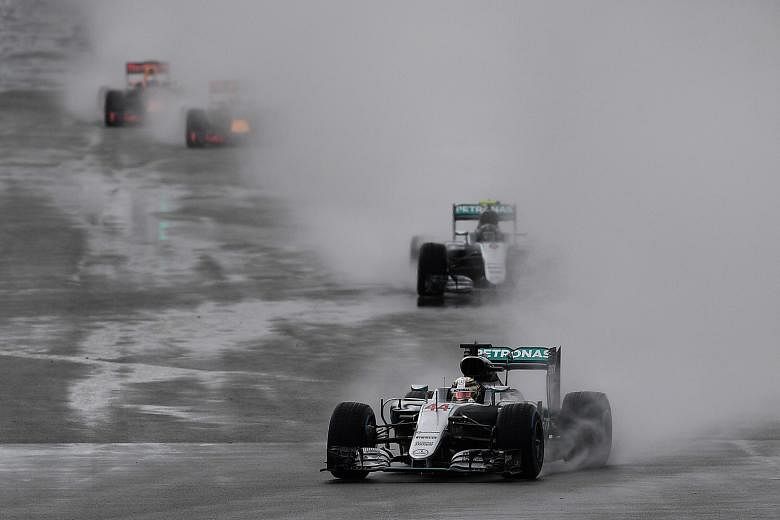Without question, Lewis Hamilton delivered the performance his myriad fans had travelled to Silverstone to see in Sunday's gripping British Grand Prix.
It was a race that had everything: A national hero battling against adversity; a fast rival intent on protecting his points advantage in an equal car; an upstart kid doing his utmost to upstage both of them; changeable weather that made parts of the track a skating rink, and sent both the national hero and the kid momentarily skidding towards disaster on one heart-in-mouth occasion; a last-minute letdown for the team-mate who had triggered their collision last time around; and a late penalty that reduced said team-mate's advantage to a mere point.
Oh, and the three-in-a-row victor crowd-surfing and dancing with a TV camera after his slow-down lap.
For sure, there isn't a lot wrong with F1 right now, regardless of what some might have you believe for their own disparate ends. The racing is good, and there are plenty of ingredients to keep things bubbling along.
But two things at Silverstone showcased that all is far from perfect.
 Amid the spray and grey conditions in the early stages of the British Grand Prix on Sunday, Lewis Hamilton leads his Mercedes team-mate Nico Rosberg. Hamilton won the race, his third straight victory in his home GP and his fourth British title in total. PHOTO: AGENCE FRANCE-PRESSE
Amid the spray and grey conditions in the early stages of the British Grand Prix on Sunday, Lewis Hamilton leads his Mercedes team-mate Nico Rosberg. Hamilton won the race, his third straight victory in his home GP and his fourth British title in total. PHOTO: AGENCE FRANCE-PRESSE In practice, Sebastian Vettel again tried the much-vaunted halo, the unsightly roll-hoop that is intended to offer superior cockpit head protection for drivers. Almost certainly it will be mandatory from next year onwards, changing the face of single-seater cars forever. Yet Vettel let it be known, having previously said it was okay, that he no longer likes the limited visibility it offers.
Here's the paradox: The halo spearheads the FIA's latest safety campaign, which was heightened by Jules Bianchi's death last July following his accident at Suzuka in 2014. A halo would have had little effect there, but the idea has such a head of steam that it is inevitable that it will be made part of the rules very soon.
Another aspect of the safety push is the increasing use of the safety car at the start of wet races. We saw it in Monaco, and again at Le Mans where, if you can believe it, the field in the 24-hour endurance event ran behind one for 50 minutes, drawing catcalls from, and the throwing of rubbish by, increasingly irate spectators.
In the past, drivers made standing starts from their grid positions, and it was up to them to find which bits of the track held treacherous standing water and to negotiate their way through such hazards. Today's nanny state mentality precludes that.
Interestingly, both Nico Rosberg and Max Verstappen agreed that the use of the safety car was appropriate at Silverstone, even though it stayed out for five laps and ruined the spectacle.
"Especially on the main straight there was quite a lot of water, but maybe it was out a bit too long," the Dutchman said. "I was ready to race after maybe two laps."
Hamilton disagreed: "I personally believe we could have started on the grid - but for sure there were patches of water all over the place and it would have been tricky - but that's what motor racing's about. For sure we did stay out far too long. But it would have been fun.
"It was easily just as wet in 2008, if not more so, when we started from the grid in the normal way."
Meanwhile, Rosberg's post-race demotion from second to third, via a 10-second penalty imposed by stewards for radio advice received about his gearbox, showed that the FIA's clampdown on radio messages has intensified rather than eased back after the problems Hamilton had experienced with engine mode settings during the race in Baku, Azerbaijan last month.
The radio conversation between Rosberg and his team in the closing stages of the race was in itself neither dangerous nor particularly wrong. But what is questionable is the FIA's insistence that teams are still not permitted to inform their drivers of imminent problems or potential safety hazards in performance that the drivers may not be aware of.
If safety measures are to be applied so rigorously in other areas that they will change the manner in which the public regard the cars, it surely makes sense that some basic warnings remain permissible in areas of significant importance.


